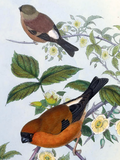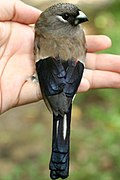Superregnum: Eukaryota
Cladus: Unikonta
Cladus: Opisthokonta
Cladus: Holozoa
Regnum: Animalia
Subregnum: Eumetazoa
Cladus: Bilateria
Cladus: Nephrozoa
Superphylum: Deuterostomia
Phylum: Chordata
Subphylum: Vertebrata
Infraphylum: Gnathostomata
Megaclassis: Osteichthyes
Cladus: Sarcopterygii
Cladus: Rhipidistia
Cladus: Tetrapodomorpha
Cladus: Eotetrapodiformes
Cladus: Elpistostegalia
Superclassis: Tetrapoda
Cladus: Reptiliomorpha
Cladus: Amniota
Classis: Reptilia
Cladus: Eureptilia
Cladus: Romeriida
Subclassis: Diapsida
Cladus: Sauria
Infraclassis: Archosauromorpha
Cladus: Crurotarsi
Divisio: Archosauria
Cladus: Avemetatarsalia
Cladus: Ornithodira
Subtaxon: Dinosauromorpha
Cladus: Dinosauriformes
Cladus: Dracohors
Cladus: Dinosauria
Ordo: Saurischia
Cladus: Eusaurischia
Subordo: Theropoda
Cladus: Neotheropoda
Cladus: Averostra
Cladus: Tetanurae
Cladus: Avetheropoda
Cladus: Coelurosauria
Cladus: Tyrannoraptora
Cladus: Maniraptoromorpha
Cladus: Maniraptoriformes
Cladus: Maniraptora
Cladus: Pennaraptora
Cladus: Paraves
Cladus: Eumaniraptora
Cladus: Avialae
Infraclassis: Aves
Cladus: Euavialae
Cladus: Avebrevicauda
Cladus: Pygostylia
Cladus: Ornithothoraces
Cladus: Ornithuromorpha
Cladus: Carinatae
Parvclassis: Neornithes
Cohors: Neognathae
Cladus: Neoaves
Cladus: Telluraves
Cladus: Australaves
Ordo: Passeriformes
Subordo: Passeri
Infraordo: Passerida
Superfamilia: Passeroidea
Familia: Fringillidae
Subfamilia: Carduelinae
Genus: Pyrrhula
Species: P. aurantiaca – †P. crassa – P. erythaca – P. erythrocephala – P. leucogenis – P. murina – P. nipalensis – P. pyrrhula
Name
Pyrrhula Brisson, 1760
Typus
Loxia pyrrhula Linnaeus, 1758 = Pyrrhula pyrrhula
References
Primary references
Brisson, M.J. 1760. Ornithologie ou méthode contenant la division des oiseaux en ordres, sections, genres, especes & leurs variétés. A laquelle on a joint une description exacte de chaque espece, avec les citations des auteurs qui en ont traité, les noms qu'ils leur ont donnés, ceux que leur ont donnés les différentes nations, & les noms vulgaires. Ouvrage enrichi de figures en taille-douce. Tome I. - pp. j-xxiv [= 1-24], 1-526, j-lxxiij [= 1-73], Pl. I-XXXVII [= 1-37]. Paris. (Bauche). Original description p.36 BHL Reference page.
References
Rando, J.C., Pieper, H., Olson, S.L., Pereira, F. & Alcover, J.A. 2017. A new extinct species of large bullfinch (Aves: Fringillidae: Pyrrhula) from Graciosa Island (Azores, North Atlantic Ocean). Zootaxa 4282(3): 567–583. DOI: 10.11646/zootaxa.4282.3.9. Reference page.
Vernacular names
English: Bullfinches
日本語: ウソ属
Pyrrhula is a small genus of passerine birds, commonly called bullfinches, belonging to the finch family (Fringillidae). The genus has a Palearctic distribution; almost all species occur in Asia, with two species exclusively in the Himalayas and one species, P. pyrrhula, also occurring in Europe. The Azores bullfinch (P. murina) is a critically endangered species (about 120 pairs remaining), occurring only in the east of the island of São Miguel in the Azores archipelago.
Analysis of the mtDNA cytochrome b sequence indicates that the Holarctic pine grosbeak (Pinicola enucleator) is the closest living relative of this genus. Arguably, it could be included in Pyrrhula, but more probably is a distinct offshoot of a common ancestor, with the pine grosbeak as the sister group to the ancestor of the bullfinches.[1][2] The evolution of the bullfinch species started soon after the pine grosbeak's ancestors diverged from them (at the end of the Middle Miocene, about 12 mya), and it is quite possible that the latter species evolved in North America; what is fairly certain is that the bullfinch radiation started in the general area of the Himalayas. The mountain finches also seem to be part of this clade.[3]
Bullfinches have glossy black wings and tail feathers. They show a white rump. The legs and feet are fleshy brown. Their short, swollen bill is adapted to eat buds, and is black except for the brown bullfinch, which has a grey or greenish-grey bill. The males can be distinguished by their orange or red breast. Some species have a black cap.
Taxonomy
The genus Pyrrhula was introduced in 1760 by the French zoologist Mathurin Jacques Brisson.[4][5] The name was derived by tautonymy from the binomial name of the Eurasian bullfinch Loxia pyrrhula introduced by Linnaeus in 1758.[5][6]
The bullfinches in the genus Pyrrhula are sister to the pine grosbeak, the only species placed in the genus Pinicola.[7]
Species
P. p. griseiventris from the Kurile Islands, illustrated by William Matthew Hart, 1888
There are eight extant and one extinct recognized species in the genus:[8][9]
| Image | Scientific name | Common Name | Distribution |
|---|---|---|---|
 |
Pyrrhula aurantiaca | Orange bullfinch | India and Pakistan |
 |
Pyrrhula erythaca | Grey-headed bullfinch | Bhutan, China, India, Myanmar, and Nepal |
 |
Pyrrhula owstoni | Taiwan bullfinch (split from P. erythaca)[10] | Taiwan |
 |
Pyrrhula erythrocephala | Red-headed bullfinch | Bhutan, northern India, Nepal |
 |
Pyrrhula leucogenis | White-cheeked bullfinch | the Philippines |
 |
Pyrrhula murina | Azores bullfinch | São Miguel Island, in the Azores archipelago of Macaronesia in the North Atlantic Ocean. |
 |
Pyrrhula nipalensis | Brown bullfinch | Bhutan, China, India, Malaysia, Myanmar, Nepal, Pakistan, Taiwan, and Vietnam. |
 |
Pyrrhula pyrrhula | Eurasian bullfinch | across Europe and temperate Asia. |
†Greater Azores bullfinch Pyrrhula crassa [11]
References
Arnaiz-Villena, A; et al. (2001). "Phylogeography of crossbills, bullfinches, grosbeaks, and rosefinches". Cellular and Molecular Life Sciences. 58 (8): 1159–1166. doi:10.1007/pl00000930. PMID 11529508. S2CID 6241573.
Arnaiz-Villena, Antonio; Gomez-Prieto, Pablo; Ruiz-Del-Valle, Valentin (2009). "Phylogeography of Finches and sparrows". In Rechi, Leopold J (ed.). Animal Genetics. Nova Science Publishers. p. 55. ISBN 978-1-60741-844-3.
Marten, Jill A. & Johnson, Ned K. (1986). "Genetic relationships of North American cardueline finches" (PDF). Condor. 88 (4): 409–420. doi:10.2307/1368266. JSTOR 1368266.
Brissons, M.J. (1760). Ornithologie, Volume 1. Vol. 1. Paris: Chez C.J.-B. Bauche. p. 36.
Paynter, Raymond A. Jnr., ed. (1968). Check-list of birds of the world, Volume 14. Vol. 14. Cambridge, Massachusetts: Museum of Comparative Zoology. p. 293.
Linnaeus, C. (1758). Systema Naturæ per regna tria naturae, secundum classes, ordines, genera, species, cum characteribus, differentiis, synonymis, locis, Volume 1 (in Latin). Vol. 1 (10th ed.). Holmiae:Laurentii Salvii. pp. 171–172.
Zuccon, Dario; Prŷs-Jones, Robert; Rasmussen, Pamela C.; Ericson, Per G.P. (2012). "The phylogenetic relationships and generic limits of finches (Fringillidae)". Molecular Phylogenetics and Evolution. 62 (2): 581–596. doi:10.1016/j.ympev.2011.10.002.
Gill, Frank; Donsker, David (eds.). "Finches, euphonias". World Bird List Version 5.2. International Ornithologists' Union. Retrieved 5 June 2015.
"Species Updates – IOC World Bird List". Retrieved 2021-01-12.
Dong, Feng; Li, Shou-Hsien; Chiu, Chi-Cheng; Dong, Lu; Yao, Cheng-Te; Yang, Xiao-Jun (2020). "Strict allopatric speciation of sky island Pyrrhula erythaca species complex". Molecular Phylogenetics and Evolution. 153: 106941. doi:10.1016/j.ympev.2020.106941.
Rando, J.C; Pieper, H; Olson, Olson Storrs; Pereira, F; Alcover, J.A (2017). "A new extinct species of large bullfinch (Aves: Fringillidae: Pyrrhula) from Graciosa Island (Azores, North Atlantic Ocean)" (PDF). Zootaxa. 4282 (3): 567–583. doi:10.11646/zootaxa.4282.3.9. Retrieved 6 August 2017.
Retrieved from "http://en.wikipedia.org/"
All text is available under the terms of the GNU Free Documentation License

